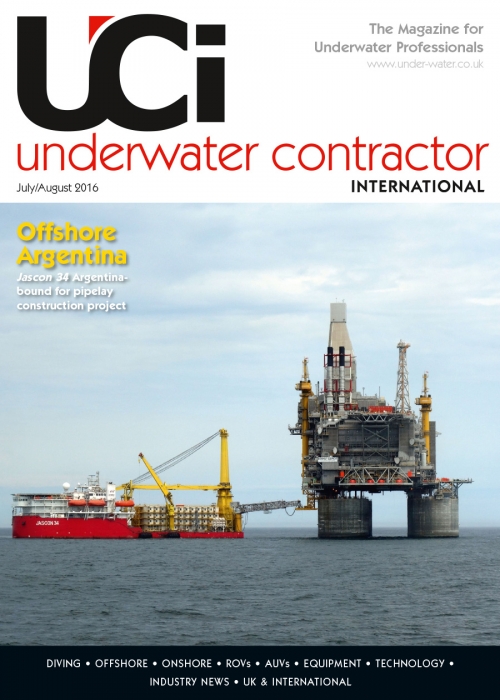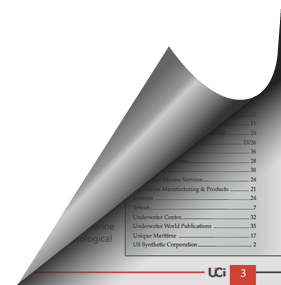
The Magazine for Underwater Professionals
![]() May/Jun 2015
May/Jun 2015
ASSOCIATION NEWS
Society for Underwater Technology
Carbon capture
The United Kingdom has made a significant commitment to reduce emissions of greenhouse gases. The efforts to achieve this include the reduction of hydrocarbon consumption, developing alternative sources of energy supply, and plans to develop a number of CCS (carbon capture and sequestration, or storage) projects. CCS prevents the release of carbon dioxide to the atmosphere by storing it in depleted hydrocarbon reservoirs or deep saline aquifers. UK legislation requires that any carbon storage is performed offshore; consequently most subsea engineers are aware of CCS, but much less familiar with the details.
The March evening meeting of the SUT Aberdeen Branch took an in-depth look at CCS. Two large-scale offshore CCS projects are currently in FEED stage. The first is the Shell Peterhead CCS project, to transport carbon dioxide from the Peterhead power station to the Goldeneye field in the central North Sea, while the second is the White Rose project from the Drax power station in Yorkshire. The meeting took a technical introduction to the challenges of CCS, the market and development perspective, and a detailed review of the work by Shell on the Peterhead CCS project.
The meeting was chaired with customary good humour by Richard Gibson of Kirktyne Ltd. Richard first introduced Michael Vigne of Apsys, who gave a short “techbite” on decision making, and the use of modelling tools to predict the complex behaviour of multiple systems, or (in aerospace industry terminology) “systems of systems”. As Michael noted, anticipating the outcome of complex systems such as underground gas storage does not necessarily require time travel, or De Lorean sports cars!
The first detailed presentation was given by Helen Coleman, principal process engineer at Genesis. Helen discussed the technical challenges of CCS and the transportation of carbon dioxide. Carbon dioxide has numerous fundamental differences from the hydrocarbons with which the oil and gas industry is so familiar; carbon dioxide is heavier than air, odourless, highly sensitive to thermal expansion, subject to severe Joule-Thomson cooling, and yet (there’s always a bright side…) just as toxic. Helen discussed some of the problems by means of examples, including its corrosivity in the presence of water, incompatibility with non-metallic materials such as elastomers and downhole cements, and the need for venting rather than flaring when controlled disposal of gas is necessary. Carbon dioxide is transported in dense phase to ensure the high density and low viscosity. However there is significant uncertainty in carbon dioxide phase behaviour and its modelling, particularly in the presence of hydrocarbons and other impurities.
Helen also discussed how carbon dioxide can be used for enhanced oil recovery (EOR) and may allow 5% to 15% improvement in reservoir yield through tertiary oil extraction. Rather ironically, most worldwide CCS experience has been obtained through EOR applications.
REVIEW
Helen’s excellent technical overview was followed by a market review by Sam Gomersall, commercial director of Pale Blue Dot. Sam gave an overview of the history and current status of CCS projects, from 2007 to the present day. Sam provided a striking graphical depiction of carbon dioxide emissions from the UK which demonstrated how much of the UK carbon dioxide output comes from a small number of (mostly coal-fired) power stations. In terms of CCS, the process has been a long and slow one, and numerous projects have been considered but have failed to progress beyond conceptual stage. The Peterhead and White Rose projects are the current leaders and the only two projects in the UK currently in FEED. Two earlier projects (Kingsnorth and Longannet) completed FEED but were withdrawn, while two further projects (Captain and Hatfield/Don Valley) are lined up as “second phase” projects to follow Peterhead and White Rose.
Sam discussed the very slow progress which, in spite of strong R&D funding for CCS in the UK, has greatly affected investor and utility company interest. However, the requirement is still there, and CCS plays a key role in reducing carbon emissions. Despite the slow progress, Sam’s passion for CCS was evident in a very frank but positive presentation.
The final two presentations of the evening looked at the Peterhead project, under development by Scottish and Southern Energy, and Shell. The first presentation was given by Joost van der Wal, senior project engineer at Shell, who gave an overview of the project. Joost started by presenting some stark global statistics about climate change. Global energy demand is predicted to double by 2050, of which 70% is still to be met by fossil fuels. However CCS has the capability to deliver 17% of the required mitigation by 2050, and is a key feature in long-term plans for hydrocarbon production in a low-carbon future. Shell does not expect the Peterhead project to be make a significant impact on carbon emissions itself, but hopes that the project will plant the seed for the future.
LOOK
Joost moved on to look at the project and the modifications planned at Peterhead, including a very large absorber tower, a regeneration tower to extract the amine used to absorb the carbon dioxide, and the compression and dehydration plant. Further modifications are planned at the Goldeneye platform, including change-out of existing piping to stainless steel, and conversion of three of the four platform wells for carbon dioxide injection and the one remaining well for reservoir monitoring. Detailed design is planned for 2016 with construction to follow, and commissioning and start-up in 2019.
Joost’s wide ranging and enthusiastic introduction was followed by a detailed presentation on the offshore pipeline system by Adrian Ledingham, regional engineering director of Wood Group Kenny. Adrian described the work which Wood Group Kenny has performed on the FEED of the offshore pipeline from Peterhead to Goldeneye. The project will make use of the existing (decommissioned) 20-inch pipeline from Goldeneye to St Fergus and connect a new 20-inch line at Peterhead to a subsea tie-in point in the existing 20-inch pipeline. The shore approach for the new pipeline at Peterhead is likely to be constructed using horizontal directional drilling to minimise the site impact. At the subsea tie-in, the existing 20-inch pipeline will be cut and the redundant St Fergus section preserved and capped. The new pipeline will be connected to the pipeline to Goldeneye via a tie-in spool and a hyperbaric welded flange connection. At Goldeneye, the existing SSIV structure must be replaced because of SSIV seal incompatibility with carbon dioxide and the orientation of the original check valve for gas export, not import. Adrian’s concise presentation brought the challenges and novelties of CCS back to home for subsea engineers, and illustrated how the challenges of CCS projects can be met through a combination of conventional and creative subsea engineering.
All the presentations gave different perspectives on CCS and its impact on the offshore industry, and resulted in a fascinating and highly stimulating overview, and much interest and many questions from the audience. The audience of 83 continued to debate over the buffet dinner provided by the Treetops Hotel.
David Kaye
The SUT evening meeting ‘Flow Assurance: Cost Effective Project Design to Life of Field Asset Management’ was conducted by Shaun Johnston, the Process and Flow Assurance regional manager at Wood Group Kenny. His presentation gave an overview of flow assurance, and how it helps to deliver value throughout the project lifecycle; which is of particular significance at present, with capital and operational expenditure being squeezed due to low oil prices.
Iain Knight chaired the meeting, initially greeting the audience members and giving an outline of the SUT events planned for the coming months. Iain then introduced Shaun and the presentation got under way.
Shaun started off by giving a brief introduction to Wood Group Kenny (part of the wider Wood Group). Wood Group Kenny is a company that provides life cycle engineering, project management and integrity solutions for the offshore and onshore oil and gas industry. Flow assurance is one of its eight main business streams.
We learnt that the discipline of flow assurance can be broadly categorised into flow and fluids (or production chemistry). Flow can be described as the thermo-hydraulic analysis of a single phase or multiple phases during transportation; and fluids (or production chemistry) is the analysis of the fluids themselves to mitigate unwanted issues such as hydrates, wax and asphaltenes.
Flow assurance engineering on projects can then be split into what it caters for; design and operations. Flow assurance for design covers the sizing of equipment, and the analysis of pressure, temperature and flowrates while flow assurance for operations covers operating guidelines, flow assurance management systems and optimisation.
Shaun spent some time going over the current state of affairs in the industry, showing why it is vitally important that engineers can maximise value added due to the recent low oil prices and high capital costs in the industry.
The key tasks that are carried out by flow assurance throughout a project’s lifecycle were presented next. Shaun went through examples showing how engaging flow assurance at each project stage can add significant value. In some examples, effective flow assurance meant the difference between a project’s economic failure and economic success.
DELIVER
Overall, Shaun gave a fascinating insight into flow assurance in the oil and gas industry and showed how flow assurance can really add value. Ultimately we learnt that the value added when flow assurance works in parallel with other disciplines to deliver cost effective solutions far exceeds the value of flow assurance alone; this is the key to the success of any project, particularly in the current economic climate.
After the presentation, numerous questions were asked by members of the audience; both of a technical and philosophical nature. Shaun answered the questions fluently; after which, we retired for some well-earned cheese and wine.
Daniel Wong


